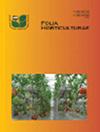“Titicaca”藜对低盐度条件的敏感性
IF 1.8
4区 农林科学
Q2 HORTICULTURE
引用次数: 3
摘要
藜麦(Chenopodium Quinoa Will.)是安第斯山脉的一年生草本植物。近年来,由于其作为食品的高品质、对农业生态条件的广泛适应性和对不同非生物胁迫的抗性,人们对其越来越感兴趣。在这项工作中,我们评估了藜麦植物cv的生长模式。“的的喀喀岛”,受到不同程度的盐度,重点是叶片产量和营养成分。从这个意义上说,结果表明高浓度的盐度对藜麦植物的生长有负面影响。事实上,与其他处理相比,200 mM NaCl处理降低了植物的光合速率和叶绿素和类胡萝卜素的水平。同样,已经证明盐度的逐渐增加对蒸腾、气孔导度和光合速率有负面影响,导致茎部生物量、叶面积和养分吸收显著减少,但叶干重(DW)产量没有下降。然而,在水分利用效率和生理盐水腺数量方面,200 mM NaCl处理的效果最好。根据我们的研究结果,藜麦植株cv。“的的喀喀湖”似乎能耐受中等浓度的盐度(50-100 mM NaCl)。该研究可作为地中海地区这一鲜为人知的栽培品种的参考,因为它可以成为中度盐度问题地区的替代作物。本文章由计算机程序翻译,如有差异,请以英文原文为准。
Sensitivity of quinoa cv. ‘Titicaca’ to low salinity conditions
Abstract Quinoa (Chenopodium quinoa Will.) is an annual herbaceous Andean plant. In recent years there is a growing interest on it due to its high quality as food, its wide adaptation to agroecological conditions and resistance to different abiotic stresses. In this work, we evaluate the growth pattern of quinoa plants cv. ‘Titicaca’, subjected to different levels of salinity, focusing on leaf production and nutrient content. In this sense, the results have shown that a high concentration of salinity negatively affects the growth of quinoa plants. In fact, plants grown with 200 mM NaCl reduced the photosynthetic rate and levels of chlorophylls and carotenoids in comparison with the rest of the treatments. Likewise, it has been proven how the progressive increase in salinity has negative effects on transpiration, stomatal conductance and photosynthetic rate, with significant subsequent reductions in shoot biomass, leaf area and nutrient adquisition, but without a decline in leaf dry weight (DW) production. However, the treatment of 200 mM NaCl demonstrated the best results regarding the water-use efficiency, as well as the number of saline glands. According to our results, the quinoa plant cv. ‘Titicaca’ seems to be tolerant to moderate concentrations of salinity (50–100 mM NaCl). This study could serve as a reference on this little known and cultivated species in the Mediterranean region, since it could become an alternative crop in areas with moderate salinity problems.
求助全文
通过发布文献求助,成功后即可免费获取论文全文。
去求助
来源期刊

Folia Horticulturae
Agricultural and Biological Sciences-Horticulture
CiteScore
3.40
自引率
0.00%
发文量
13
审稿时长
16 weeks
期刊介绍:
Folia Horticulturae is an international, scientific journal published in English. It covers a broad research spectrum of aspects related to horticultural science that are of interest to a wide scientific community and have an impact on progress in both basic and applied research carried out with the use of horticultural crops and their products. The journal’s aim is to disseminate recent findings and serve as a forum for presenting views as well as for discussing important problems and prospects of modern horticulture, particularly in relation to sustainable production of high yield and quality of horticultural products, including their impact on human health.
 求助内容:
求助内容: 应助结果提醒方式:
应助结果提醒方式:


